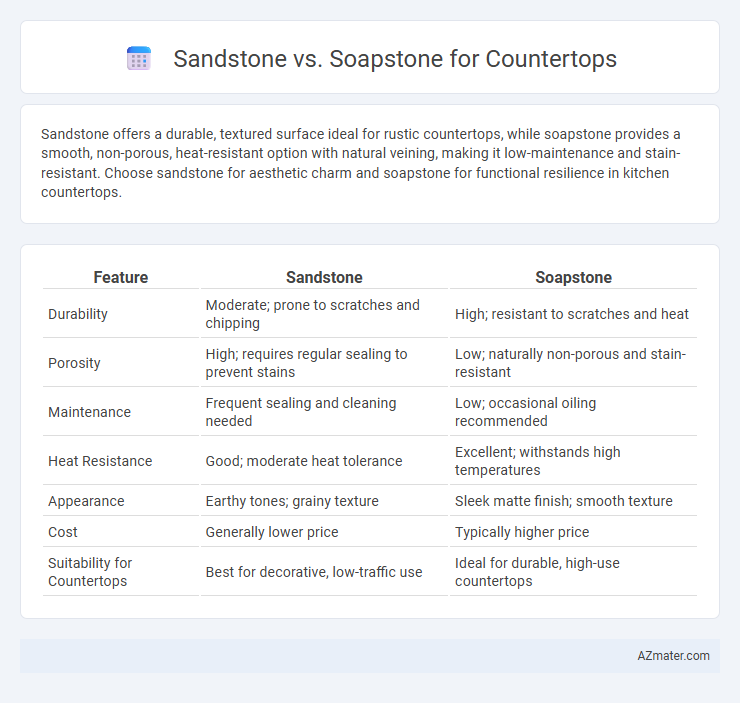Sandstone offers a durable, textured surface ideal for rustic countertops, while soapstone provides a smooth, non-porous, heat-resistant option with natural veining, making it low-maintenance and stain-resistant. Choose sandstone for aesthetic charm and soapstone for functional resilience in kitchen countertops.
Table of Comparison
| Feature | Sandstone | Soapstone |
|---|---|---|
| Durability | Moderate; prone to scratches and chipping | High; resistant to scratches and heat |
| Porosity | High; requires regular sealing to prevent stains | Low; naturally non-porous and stain-resistant |
| Maintenance | Frequent sealing and cleaning needed | Low; occasional oiling recommended |
| Heat Resistance | Good; moderate heat tolerance | Excellent; withstands high temperatures |
| Appearance | Earthy tones; grainy texture | Sleek matte finish; smooth texture |
| Cost | Generally lower price | Typically higher price |
| Suitability for Countertops | Best for decorative, low-traffic use | Ideal for durable, high-use countertops |
Introduction to Sandstone and Soapstone Countertops
Sandstone and soapstone countertops offer unique aesthetic and functional qualities ideal for kitchen and bathroom surfaces. Sandstone, composed primarily of quartz and feldspar, provides a durable, textured appearance with natural warmth and earthy tones. Soapstone, a metamorphic rock rich in talc, boasts a smooth, non-porous surface resistant to stains and heat, making it highly practical for everyday use.
Composition and Physical Properties
Sandstone consists primarily of quartz and feldspar grains cemented by silica, calcite, or iron oxide, offering moderate hardness but increased porosity compared to soapstone. Soapstone is composed mainly of talc, magnesium, and chlorite, resulting in a softer, non-porous surface that excels in heat resistance and durability. The higher talc content in soapstone contributes to its smooth texture and superior stain resistance, making it less prone to scratches and chemical damage than sandstone.
Appearance and Aesthetic Appeal
Sandstone countertops offer a warm, earthy aesthetic with natural grain patterns and a matte finish that enhances rustic and traditional decor styles. Soapstone features a smooth, non-porous surface with a rich, dark color palette that deepens over time, providing an elegant, timeless look suitable for modern or classic kitchens. Both materials age gracefully but soapstone's subtle veining and ability to develop a soft patina make it particularly prized for sophisticated, understated elegance.
Durability and Strength Comparison
Sandstone countertops offer moderate durability with a hardness rating of 6-7 on the Mohs scale, making them resistant to scratches but vulnerable to staining and chipping due to their porosity. Soapstone, rated around 2.5-4 on the Mohs scale, is softer yet exceptionally dense and non-porous, providing superior resistance to heat, stains, and acids, which enhances its longevity in kitchen environments. The inherent durability of sandstone requires regular sealing to maintain strength, whereas soapstone's natural resistance reduces maintenance needs, making it more suitable for heavy-use countertops.
Maintenance and Care Requirements
Sandstone countertops require regular sealing to prevent staining and water damage due to their porous nature, making maintenance more frequent compared to soapstone. Soapstone is highly dense and non-porous, resisting stains and bacteria, and only needs periodic oiling to maintain its rich, dark patina. Both materials benefit from gentle cleaning with mild soap and water, but sandstone demands more attentive care to avoid etching and surface wear.
Heat and Stain Resistance
Soapstone countertops exhibit superior heat resistance, withstanding high temperatures without damage, making them ideal for kitchens with frequent hot pots and pans. Sandstone, however, is more porous and less heat-resistant, prone to staining and heat marks if not properly sealed and maintained. Soapstone's dense, non-porous structure also provides better stain resistance compared to the more absorbent sandstone.
Cost and Installation Considerations
Sandstone countertops generally cost less than soapstone, offering a budget-friendly option with prices ranging from $10 to $25 per square foot, while soapstone typically costs between $70 and $120 per square foot due to its durability and unique aesthetic. Installation of sandstone is simpler and faster because of its lighter weight and ease of cutting, whereas soapstone requires specialized tools and expertise due to its hardness, impacting labor costs. Choosing between the two involves balancing initial expenses and installation complexity against long-term durability and maintenance requirements.
Environmental Impact and Sustainability
Sandstone countertops are often quarried through less intensive methods, resulting in lower carbon emissions compared to soapstone, which requires more energy for extraction and processing due to its denser composition. Soapstone is favored for its durability and resistance to heat, reducing the need for frequent replacement and contributing to long-term sustainability despite its higher initial environmental cost. Both materials are natural and recyclable, but sandstone's more abundant availability and lower embodied energy typically make it a more eco-friendly choice for environmentally conscious kitchen designs.
Best Applications and Suitability
Sandstone countertops excel in outdoor applications and rustic kitchen designs due to their natural texture and durability against weathering. Soapstone offers superior chemical resistance and heat tolerance, making it ideal for laboratory surfaces and high-use kitchen countertops where stain resistance is critical. Choosing between sandstone and soapstone hinges on whether aesthetic ruggedness or functional resilience is the primary requirement for the space.
Conclusion: Choosing the Right Stone for Your Countertop
Sandstone offers a unique, rustic aesthetic with moderate durability, making it suitable for low-traffic countertops where visual appeal is prioritized. Soapstone provides superior resistance to heat, stains, and scratches, making it an ideal choice for kitchens requiring high functionality and long-lasting performance. Evaluating your lifestyle, maintenance preferences, and desired countertop performance helps determine whether the natural charm of sandstone or the resilient practicality of soapstone best fits your needs.

Infographic: Sandstone vs Soapstone for Countertop
 azmater.com
azmater.com